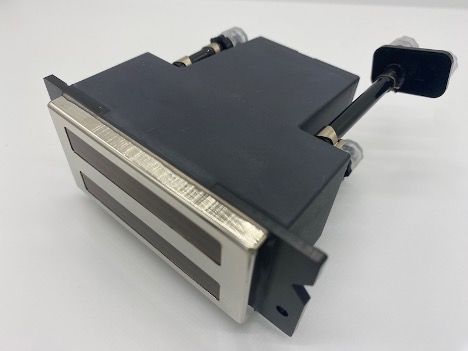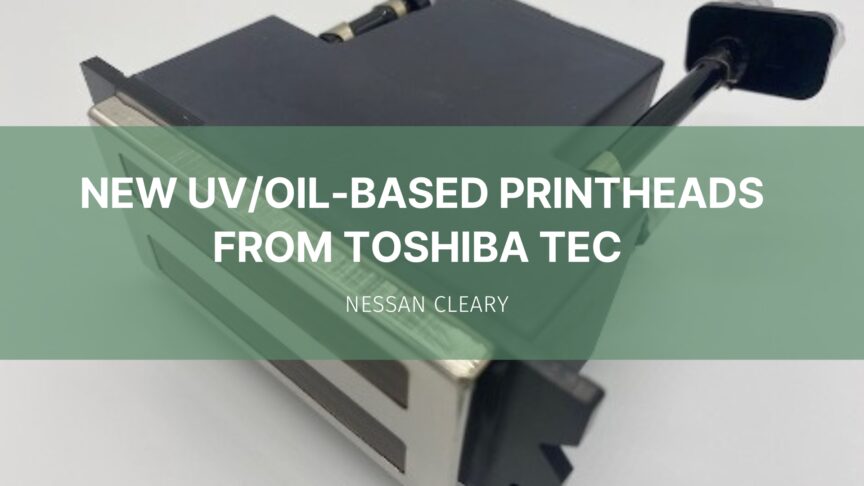Toshiba Tec, better known as TTec, is to launch two new piezo inkjet printheads, the CF6/R, which is an evolution of the existing CF3/R, and a brand new design, the CX1, which is designed to compete against the likes of the Ricoh Gen5 and Konica Minolta 1024i in the mid to high volume large format market.
Before we get to the details of the new printheads it’s worth first looking at the company’s background to understand how these heads have come about.

A bit of history
Toshiba Tec is a subsidiary of Toshiba and was set up in 1950. From 1991 it started working on R&D into inkjet printheads, going on to establish its inkjet business in 2001. Initially this was part of TTec’s Workplace Solutions division, only becoming a separate Inkjet printhead division in 2006.
TTec was one of several companies that got into the printhead business through Xaar’s program of licensing its shared wall, shear mode technology. These are bulk piezo designs where the ink chambers are built into a ceramic block that’s laced with PZT crystals that deform when an electric voltage is applied. This is the actuator mechanism that forces the ink out of the nozzles, which is known as shear mode as it causes the walls of the chamber to move from side to side.
The shared wall structure means that the walls that form each ink chamber within the ceramic block are shared with the adjacent ink chamber. The advantage is that this makes it easier to pack many nozzles close together, leading to higher resolution without using too much of the expensive piezo material. The disadvantage is that deforming one ink chamber to fire the fluid also deforms those adjacent ink chambers, leading to cross talk between the ink chambers.
All the Xaar licensees faced a further challenge in how to differentiate themselves, both from Xaar and from each other. TTec opted to do this through precision manufacturing. Dajiro Kikuchi, Oversea Sales Group Manager for TTec’s IJ Business Group, explains: “Our customers like to use our printhead because of the excellent printing quality and I believe that this has been delivered by the precision of the technology. For instance, our 600npi printhead is defined by two rows, where others had to use four rows. Doubling the printhead density is very difficult but we were able to do it. So that’s a characteristic of our printhead.”
The company was quick to adopt greyscale with its CB1 head in 2001 to increase the range of drop sizes whilst most other players were still concentrating on a single binary drop size. By 2002 TTec introduced the CA3 head which included heating and water-cooling to control the temperature around the head which previously printer OEMs had to do separately.
The CE-series heads, launched in 2005, doubled the nozzle density from 150 to 300npi. Kikuchi notes: “Almost twenty years has passed but still, most of the customers use this printhead for the sign and display market because of the printing quality.”
From 2007 TTec introduce its first heads with recirculation, the CF1-series, available in three variants for larger drop sizes from 42 to 180pL. This was succeeded by the CF3 series in 2015, which gained a new electronic driver system that allowed the droplet sizes to be fine-tuned, essentially through using a waveform. At the same time, the nozzle density was also doubled, from 300 to 600npi.
The CF6 and CF6R printheads
The new CF6 head builds on the previous CF3, using air cooling and measuring 96.7 x 29.3 x 100.7mm. There’s also a CF6R variant, which has all the same specifications except that it uses water cooling and is slightly thicker at 31.3mm with the same width and height. The CF6 and CF6R are up to 1.5 times faster than their CF3 equivalents. Kikuchi says that the main difference between the CF3 and CF6 is the drop volume and frequency. The CF6/R produces a native drop size of 6pL but can fire up to three drops to produce 12pL and 18pL drop volumes at a frequency of 12kHz.
The new head can handle both UV cured and oil-based inks. As with the CF3 series, it has complete recirculation through to the nozzles. There are 1278 nozzles, arranged in two rows, which delivers 600npi resolution with a print width of 53.95mm for a single channel. However, it can also be configured for two channels, with half the nozzles and resolution and a print width of 53.91mm.
Otherwise, it’s been designed as a drop in replacement for the CF3/R so the dimensions, electronic connections and plumbing are all the same as the older head. Kikuchi explains: “So this means that if a customer has already developed a printer with the CF3 then tomorrow the customer can use the CF6 printhead.”
These heads are aimed at a range of markets, including decoration for things such as glass, wood, and plastic, and including direct to shape as well as PCB production, coding and marking, plus label and corrugated printing.
He accepts that in Europe a lot of customers are moving towards water-based inks for single pass corrugated printing but argues that there are different applications with different levels of quality required in corrugated and that some customers will continue to use oil-based ink for corrugated while others are using UV inks. He adds: “We believe that this printhead will be suitable for the kind of corrugated application using UV-curable ink.”
Stepping up a gear
The second of these new printheads is the CX1, which has been designed for much higher productivity work and is primarily aimed at the large format print market.
The CX1 is a compact on-demand piezo printhead, measuring 97x37x110mm, with a print width of 54mm. It has 1280 nozzles, arranged in four rows, giving a resolution of 600npi for a single channel. That said, it can be configured with two channels, in which case the resolution is 300npi per colour. It can handle both UV-cured and oil-based inks and has built in temperature control with water-cooling. It’s a greyscale head with four levels, with the smallest drop being 6pL, going up to a maximum drop size of 16pL at a frequency of 47kHz.
It uses a similar architecture to TTec’s other printheads but with a different drive mode. The CF series use a three-cycle driving mode whereby the nozzles are fired in a specific sequence to avoid adjacent nozzles firing at the same time, minimising but not completely eliminating the fluidic crosstalk from the shared walls between the ink chambers.
“Speed is very important
but stability is also required
in the industrial area“
However, for the CX1, TTec has opted to only use every other nozzle so that each ink chamber in use is isolated. Kikuchi explains: “The isolated wall structure can enable us to jet the ink three times faster than the three cycle mode so it is much faster.” He adds: “Speed is very important but stability is also required in the industrial area.” Generally speaking, increasing the speed leads to lower drop placement accuracy but TTec has found that it can increase the firing frequency from 20kHz to 47kHz with very little variation, with Kikuchi noting: “Our print head is very stable regarding drop velocity versus frequency.”

